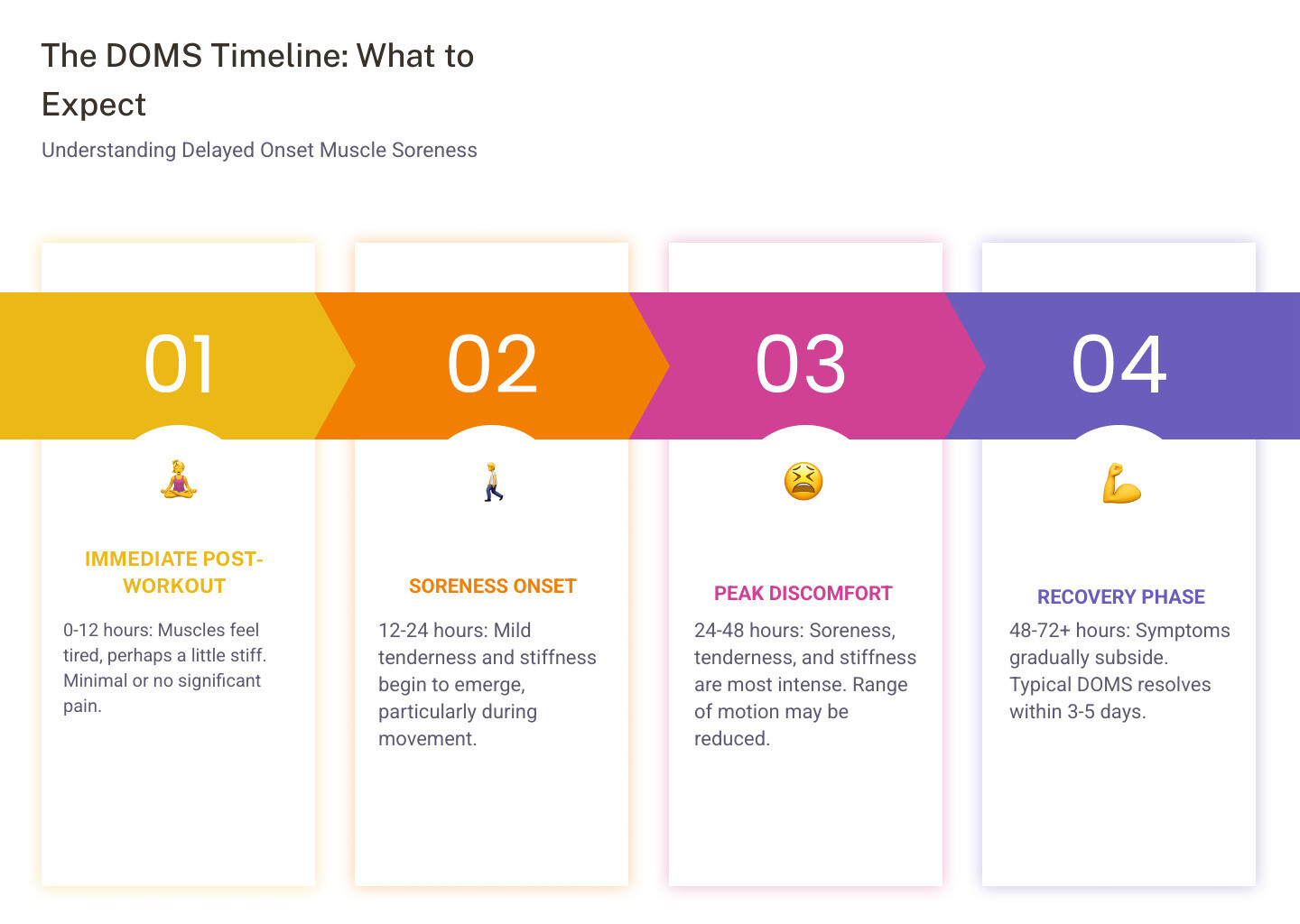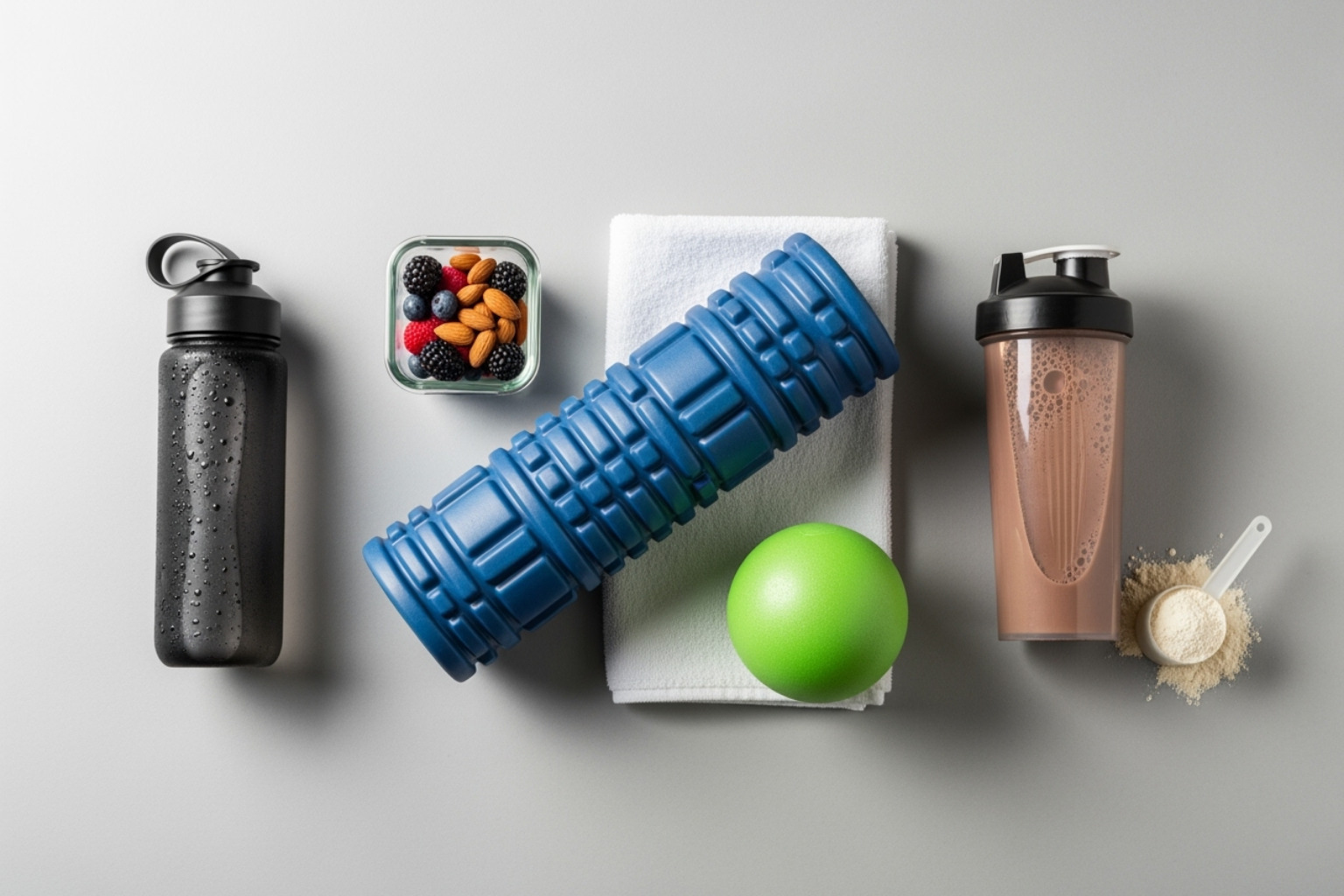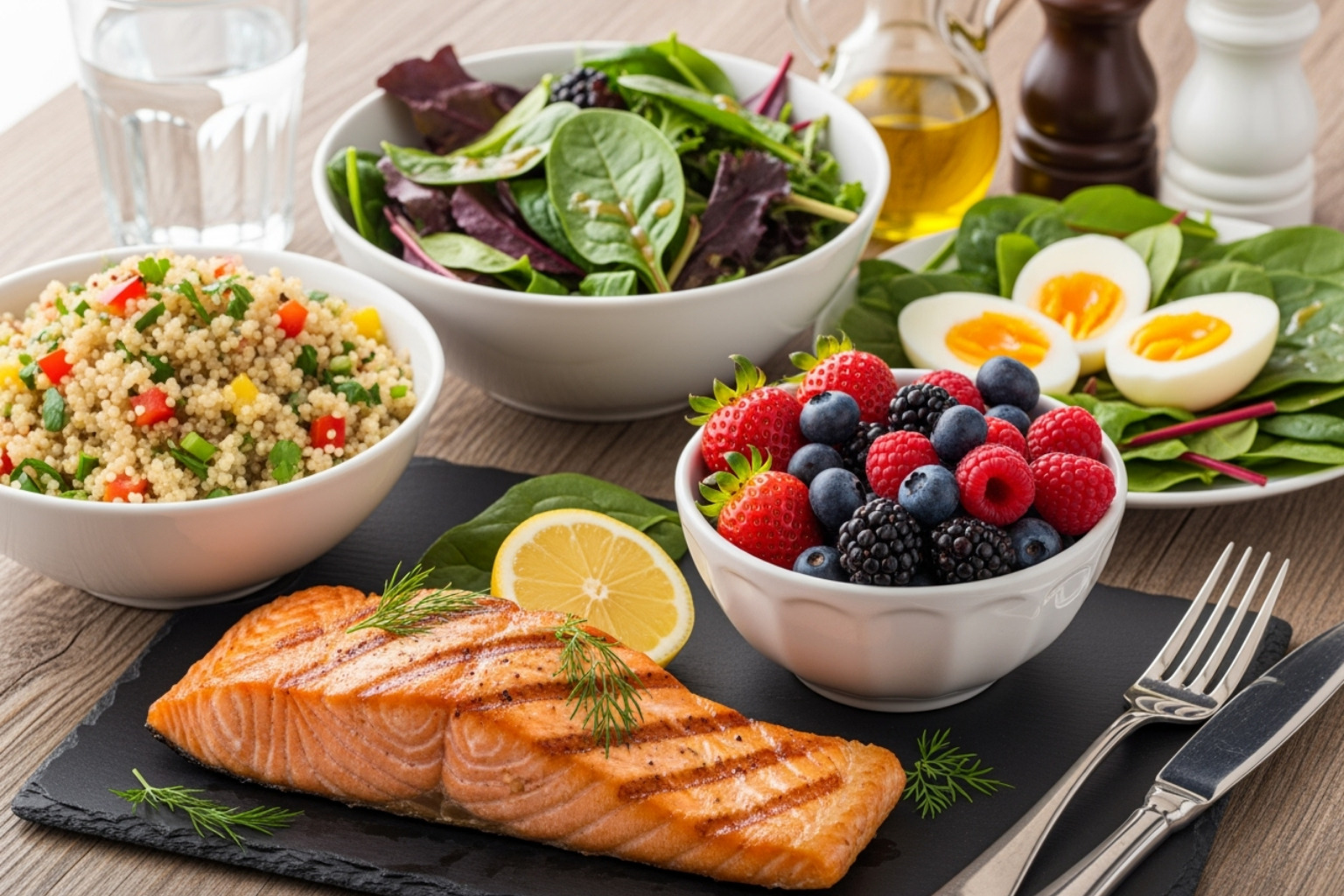What to Do When You're Sore After the Gym
Feeling sore after gym workouts is a common sign that your muscles have been challenged. But what does this soreness mean, and how can you ease it to recover faster? While many believe "no pain, no gain," extreme soreness can be a barrier to your next workout. Understanding your body's signals helps you recover smarter.
Here's a quick guide on what to do:
- Understand DOMS: The ache you feel 12-48 hours later is Delayed Onset Muscle Soreness (DOMS), caused by tiny muscle tears from new or intense exercise (American College of Sports Medicine).
- Gentle Movement: Light activities like walking or cycling boost blood flow and reduce stiffness.
- Hydrate and Eat Well: Drink plenty of water and fuel your body with protein and carbs for muscle repair.
- Temperature Therapy: Use ice to reduce inflammation or warmth to relax muscles.
- Prioritize Rest: Adequate sleep is crucial for muscle repair and growth.
- Use Topical Relief: Creams like Neuropasil offer targeted comfort for local pain.

Why You Get Sore After the Gym: The Science of DOMS
That familiar ache you feel a day or two after a tough workout is called Delayed Onset Muscle Soreness, or DOMS. It's a normal response to physical activity your body isn't used to. When you push your muscles, especially with eccentric contractions (like lowering a weight), you create tiny, microscopic tears in your muscle fibers. These aren't injuries but signals that kick off the muscle repair process.
Your body responds with inflammation to clear out damaged cells and rebuild the muscle tissue stronger than before. This repair cycle leads to greater strength and endurance. The soreness is a side effect of this process. A common myth is that DOMS is caused by lactic acid, but lactic acid is flushed from your muscles within an hour or two after a workout. The real cause behind What causes DOMS is this structural damage and your body's impressive capacity for muscle adaptation and growth.
What are the symptoms of DOMS?
DOMS symptoms typically appear 12 to 24 hours after your workout and can include (American College of Sports Medicine):
- Muscle Tenderness: Your muscles feel sensitive or painful to the touch.
- Stiffness: Movement feels difficult, and muscles feel tight.
- Reduced Range of Motion: Stiffness may make it harder to move joints freely.
- Mild Swelling: The affected muscles might look slightly puffy.
- Temporary Strength Loss: Your muscles may feel temporarily weaker.
The good news is that this pain usually peaks at 24-72 hours and then begins to ease. Knowing this timeline helps you manage expectations and plan your recovery.
Is being sore a sign of a good workout?
While feeling sore after gym sessions shows you've challenged your muscles, it's not the only sign of a good workout. When you start a new routine, DOMS is common and indicates your muscles are adapting. However, as your body gets used to the exercise, you'll likely feel less soreness. This is a positive sign of body adaptation and increased resilience, not a sign that your workouts are ineffective. You can absolutely achieve fitness gains without soreness.
In fact, chasing extreme soreness can be counterproductive and may be a sign of overtraining. This can lead to burnout or injury. The key is to listen to your body. A little soreness is fine, but you should never push through sharp pain. Finding a balance is crucial for steady progress. For more ways to manage discomfort, check out What Helps Sore Muscles.
Your Ultimate Guide to Managing Pain When You're Sore After Gym
When you're feeling sore after gym sessions, you don't have to just endure it. A toolkit of strategies can help you manage pain, speed up recovery, and get back to feeling your best.

From movement to nutrition to topical relief, let's explore the best ways to bounce back stronger. For a comprehensive overview, dive into the Best Ways to Relieve Muscle Aches with Physical Activity and Healthy Living.
Active Recovery and Gentle Movement
Though it may seem counterintuitive, active recovery is one of the best ways to combat DOMS. Engaging in gentle movement during your rest period helps increase blood flow to sore muscles, delivering nutrients and flushing out metabolic waste. Instead of heavy lifting, opt for a leisurely walk, a gentle bike ride, or light swimming. Gentle stretching and light mobility work can also improve range of motion and ease stiffness. The goal is to encourage blood flow without adding more stress. For a deeper dive, check out What is active recovery?. For specific exercises, see how to Reduce Muscle Soreness After Workout.
Nutrition and Hydration for Muscle Recovery
What you eat and drink is just as crucial as how you move. Proper nutrition and hydration provide the building blocks for muscle repair and growth.

- Protein and Carbs: Protein is essential for rebuilding muscle. Aim for 20-25 grams within two hours post-workout. Carbohydrates are equally vital for replenishing your muscles' energy stores (glycogen). A balanced post-workout meal with both is ideal.
- Anti-inflammatory Foods: Foods rich in Omega-3 fatty acids (like salmon and walnuts) and antioxidants (colorful fruits and vegetables) can help fight inflammation. Research also suggests tart cherry juice and curcumin can ease DOMS.
- Hydration: Staying hydrated is critical for all metabolic functions, including nutrient transport and waste removal. Studies confirm The importance of hydration in reducing muscle soreness. Drink plenty of water throughout the day, especially around your workouts.
Temperature Therapy: Hot and Cold Approaches
Temperature therapy can provide simple, effective relief by manipulating blood flow and nerve signals.
- Cold Therapy (Ice): This reduces inflammation and swelling by constricting blood vessels. It also numbs the area, providing pain relief. For acute soreness, apply ice packs for 10-15 minutes. Cold baths are also a popular option for all-over soreness.
- Hot Therapy (Heat): Warmth increases circulation by dilating blood vessels, which promotes muscle relaxation and eases stiffness. A warm bath or heat wraps can be very soothing. Studies confirm the Efficacy of heat treatment for muscle pain.
Alternating between hot and cold (contrast therapy) can also be effective for stimulating circulation. For more details, explore this Research on temperature therapy.
Neuropasil: Topical Relief, Massage, and Foam Rolling
External methods can provide immediate, targeted comfort when you're sore after gym workouts.
Massage and foam rolling (myofascial release) are excellent for releasing tightness, boosting blood flow, and speeding up recovery. Research shows that the Effect of sports massage can significantly reduce DOMS.
For targeted, fast-acting relief, topical solutions are a game-changer. This is where Neuropasil shines. Our natural, fast-acting cream is designed to provide soothing comfort for sore muscles. With key ingredients like Aloe, Urea, and Menthol, Neuropasil delivers relief directly to the affected area. Menthol, in particular, is known for its ability to ease DOMS pain by providing a cooling sensation. Simply apply Neuropasil to your sore muscles as directed to feel the soothing effects. For more on what makes Neuropasil effective, explore our guide to the Best Pain Relief Creams for Muscle Pain.
Soreness vs. Injury: When to Be Concerned
Learning to distinguish between normal post-workout DOMS and a genuine muscle injury is crucial for long-term fitness.
Normal DOMS is a dull, generalized ache that appears 12 to 24 hours after a workout, peaks, and then fades within a few days. You'll feel tender and stiff, but you can still move. An injury, however, is often a sharp, localized pain that occurs suddenly during exercise. It may be accompanied by a "pop" and can prevent you from moving the limb or bearing weight.
Here's a quick comparison, based on guidance from health experts:
| Symptom Feature | Delayed Onset Muscle Soreness (DOMS) | Muscle Injury (e.g., Strain, Tear) |
|---|---|---|
| Onset Time | 12-24 hours after exercise, peaks 24-72 hours | Immediately during or shortly after exercise |
| Pain Type | Dull, aching, generalized soreness | Sharp, sudden, intense, localized pain |
| Severity | Mild to moderate; allows for movement | Severe; can prevent movement or weight-bearing |
| Duration | 1-5 days; gradually improves | Longer than 5-7 days; may not improve |
| Movement | Stiffness, but movement is possible | Significant limitation or inability to move |
| Swelling | Mild or none | Often significant swelling and bruising |
| Weakness | Temporary, mild reduction in strength | Significant, immediate weakness |
If you're experiencing sharp pain during exercise, or if the pain worsens instead of improving, you're likely dealing with an injury. For more insights, check out After Workout Soreness.
Red Flags: When to See a Doctor
While being sore after gym sessions is usually temporary, certain signs demand immediate attention. See a doctor if you experience:
- Pain that persists beyond 5 to 7 days or gets worse.
- Severe swelling or bruising that appears suddenly.
- Dark-colored urine (like tea or cola), which can indicate a serious condition called rhabdomyolysis. This is a medical emergency.
- Inability to bear weight on a limb or move a joint through its full range of motion.
- Numbness or tingling, which suggests nerve involvement.
- Sharp, sudden pain during exercise, especially with a popping sensation.
- Muscle pain accompanied by fever or chills.
When these red flags appear, seek professional guidance. For more information, visit When to seek medical attention. If you're uncertain, Find a sports medicine doctor for an expert evaluation.
How to Prevent Being Excessively Sore After Gym Workouts
The best way to deal with soreness is to prevent it. While some DOMS is inevitable, you can reduce its severity with these habits:
- Gradual Progression: Increase your workout weight, duration, or intensity by no more than 10% per week to allow your body to adapt.
- Proper Warm-Up: Start with 5-10 minutes of light cardio followed by dynamic stretching (like leg swings and arm circles) to prepare your muscles.
- Cool-Down: After your workout, help your body recover with a cool-down that includes static stretching (holding stretches for 20-30 seconds). This improves long-term Improving flexibility.
- Proper Form: Using correct exercise form ensures you're engaging the right muscles and reduces injury risk.
- Stay Hydrated: Drink water before, during, and after exercise to help your muscles function optimally.
Frequently Asked Questions about Muscle Soreness
Let's tackle some of the most common questions about post-workout muscle soreness.
How long is too long to be sore after a workout?
Typical DOMS duration is two to five days. The discomfort usually peaks around the 48-hour mark, which is completely normal. However, you should be concerned if the pain lasts over 7 days or worsens significantly. At that point, it's wise to consult a healthcare professional. That individual recovery times vary based on fitness level, workout intensity, age, and nutrition.
Should I take painkillers for muscle soreness?
While over-the-counter painkillers can offer temporary relief, we recommend focusing on natural recovery methods and topical relief like Neuropasil first. Our cream delivers targeted, soothing comfort directly to the source of the discomfort without the systemic effects of oral medications. The natural blend of Aloe, Urea, and Menthol provides fast-acting relief.
Over-the-counter options may be considered for short-term use if soreness is severe, but they are not a long-term solution for regular post-workout pain. According to the NHS recommendations on painkillers, they can help, but always consult a professional before starting any new medication.
Do sore muscles mean they are growing?
Yes and no. Soreness indicates muscle damage and repair, and this process is what leads to hypertrophy (growth). In that sense, soreness is an indirect sign that your muscles are adapting.
However, growth can occur without extreme soreness. As your body adapts to training, you'll likely experience less DOMS. This is a sign of progress, not a lack of effort. Soreness is not the only indicator of an effective workout. Better measures of progress include consistent progressive overload, increased strength, and better endurance.
Conclusion: Your Next Steps for Faster Recovery
Being sore after gym sessions is a normal part of the fitness journey, signaling that your body is adapting and getting stronger. The key is to recover smarter, not just push harder.
The most important lesson is to listen to your body. Understand the difference between normal soreness and the red flags of an injury. The path to faster recovery is built on simple fundamentals:
- Active recovery to keep blood flowing.
- Proper nutrition and hydration to fuel repair.
- Temperature therapy for immediate comfort.
- Smart prevention through warm-ups and gradual progression.
Consistency over intensity is what leads to long-term success. Recovery is where the real magic happens. For targeted relief right where it hurts, Neuropasil is an essential part of your recovery toolkit. Our natural formula delivers soothing comfort directly to aching muscles. For more on how it can support your goals, read about How Neuropasil Helps Athletes with Muscle Recovery & Pain.
With the right knowledge and tools, muscle soreness doesn't have to hold you back. Manage it intelligently to achieve your personal best. For more information on various muscle discomforts, explore our resources on muscle pain.
References
We've drawn on a wealth of credible research and trusted health resources to bring you the most accurate and helpful information about muscle soreness and recovery. Here's where we found the science and expert guidance that informed this article:
The American College of Sports Medicine provides an excellent overview of what DOMS is and how it affects our bodies in their Delayed Onset Muscle Soreness (DOMS) Info Sheet.pdf?sfvrsn=8f430e18_2). Their research helped us understand the timeline and mechanisms behind that familiar post-workout ache.
For understanding the science behind what causes DOMS at a deeper level, we referenced Nahon, R. L., et al. (2021) and their systematic review on physical therapy interventions for DOMS treatment, which clarified how microscopic muscle damage leads to soreness.
The role of hydration in reducing muscle soreness was explored through an older but important study by Cleary, M. A., et al. (2005), which examined dehydration and symptoms of delayed-onset muscle soreness. Their findings showed how crucial water intake is before, during, and after exercise.
When it comes to massage and recovery, Davis, H. L., et al. (2020) conducted a comprehensive systematic review and meta-analysis on sports massage, which helped us understand why rubbing those sore muscles actually works.
The effectiveness of temperature therapy, particularly cold water immersion, was informed by Xiao, F., et al. (2023) and their meta-analysis on cold water immersion effects. For heat therapy, we looked to Petrofsky, J., et al. (2017) and their research on sustained heat treatment for DOMS.
Understanding when soreness crosses into dangerous territory, particularly regarding rhabdomyolysis, was informed by Shroff, K., et al. (2021) and their study on spinning-induced rhabdomyolysis.
The role of nutrition and supplements in recovery was explored through Tanabe, Y., et al. (2021) and their research on dietary supplementation for attenuating exercise-induced muscle damage.
For stretching and flexibility, we referenced Afonso, J., et al. (2021) and their systematic review on post-exercise stretching effectiveness, which helped clarify the benefits of proper cool-downs.
The National Health Service (NHS) Scotland provided practical guidance on pain and injuries after exercise, helping us understand when to seek medical attention.
Additional insights on active recovery came from familydoctor.org's guide to sore muscles, which offered practical advice on gentle movement during recovery.
For those seeking professional medical guidance, we included information about finding a sports medicine doctor through muhealth.org.
We also consulted broader overviews from trusted sources like Healthline on what DOMS is and treatment options, Cleveland Clinic on whether to be concerned about post-workout soreness, and Henry Ford Health on ways to ease post-workout muscle soreness.
Research on topical relief, particularly menthol-based analgesics, was informed by a study published in Tandfonline (2013) on menthol-based topical analgesics.
Additional perspectives on managing muscle soreness came from fitness industry resources including Basic-Fit on dealing with muscle pain, Delta Fitness London on why we feel sore after working out, Orlando Health on working out when sore, PureGym on preventing and relieving post-workout soreness, and Village Gym on preventing DOMS.
We also referenced emerging research from Wiecha, S., et al. (2024) on physical therapies for DOMS and Wilke, J., et al. (2021) on the potential role of fascial connective tissue in post-exercise discomfort.
These sources collectively provided the foundation for our comprehensive guide on understanding and managing muscle soreness. We're committed to providing you with information backed by solid science and trusted medical expertise, so you can make informed decisions about your recovery and health.














